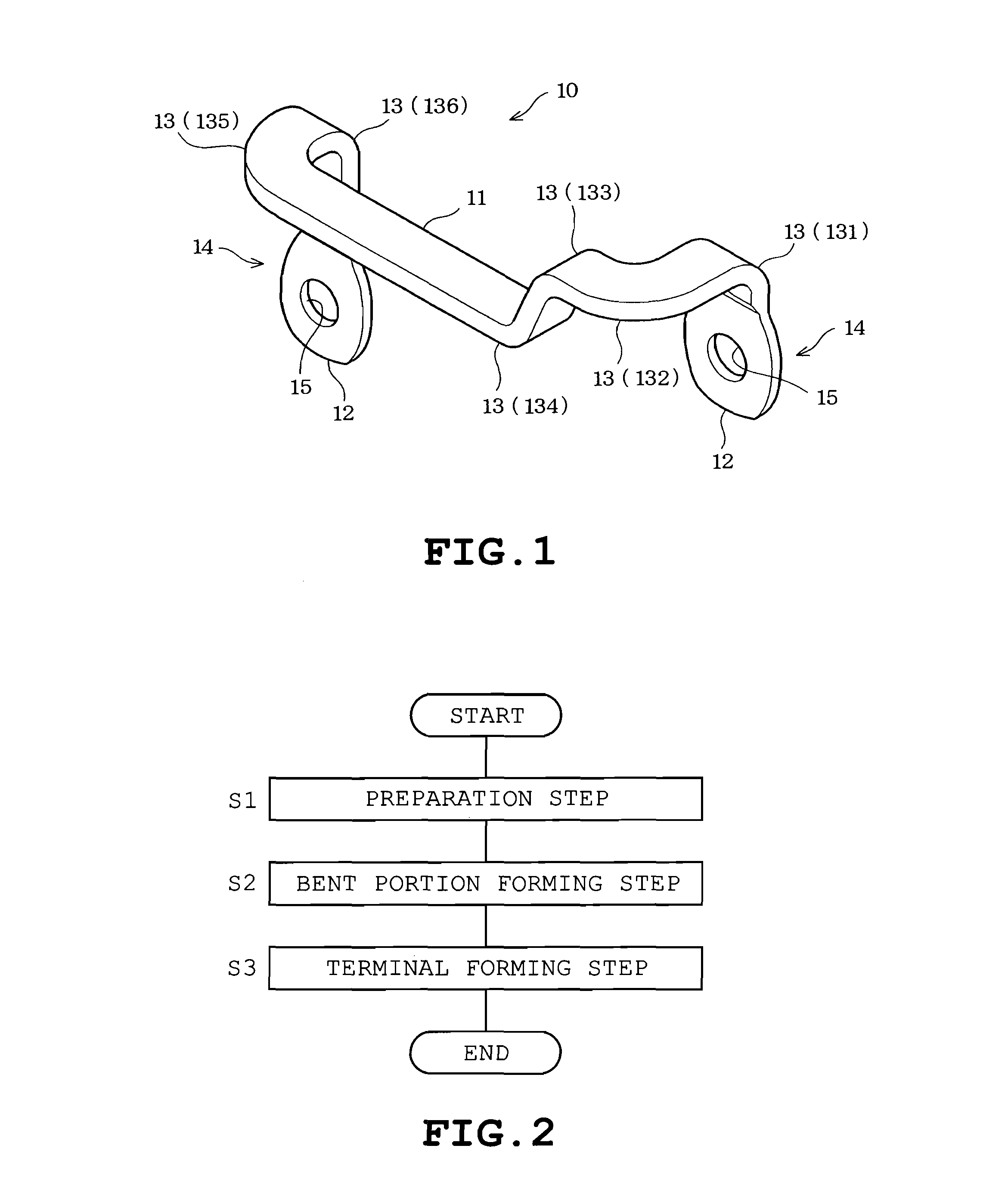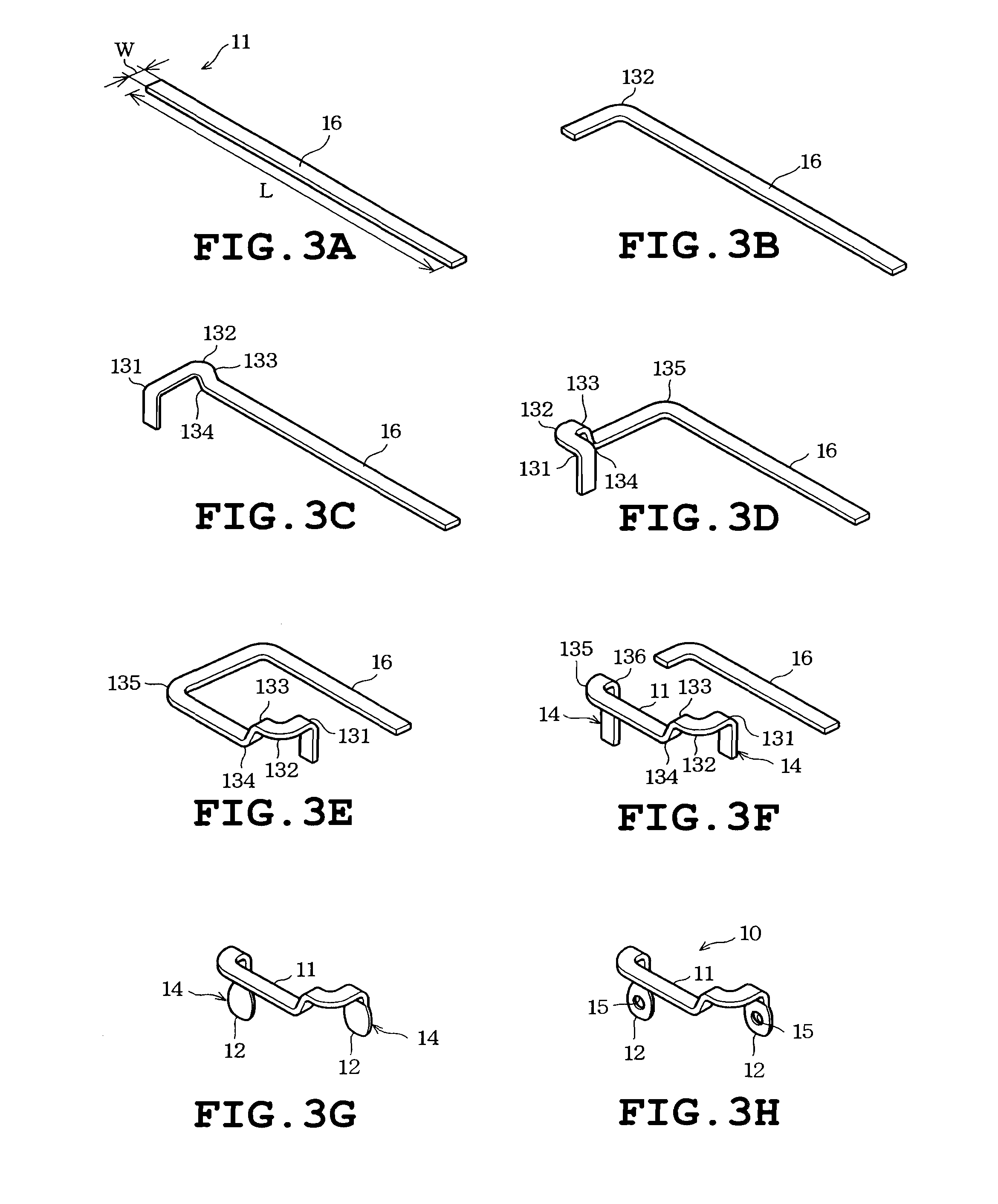Bus bar and method of manufacturing the bus bar
a bus bar and manufacturing method technology, applied in the field of bus bars, can solve the problems of reducing yield, difficult to apply bending work to material having a high hardness, and body having a predetermined flexibility may be deformed, so as to achieve more flexibility, secure workability, and high hardness
- Summary
- Abstract
- Description
- Claims
- Application Information
AI Technical Summary
Benefits of technology
Problems solved by technology
Method used
Image
Examples
first embodiment
[0026]The bus bar and the bus bar manufacturing method will be described with reference to FIGS. 1 to 5. The bus bar 10 includes a body 11 and two terminals 12 as shown in FIG. 1. The body 11 is formed into the shape of a flat plate having a rectangular section. The body 11 should not be limited to the rectangular section but may be formed into different shapes including a bar shape with a circular section, or with an elliptic or H-shaped section. The body 11 has a plurality of bent portions 13. The bent portions 13 of the body 11 include bent portions 131, 133, 134 and 136 each formed by a flatwise bending method in which each bent portion is bent in a direction of plate thickness of the flat plate-shaped body 11. Bent portions 132 and 135 are formed by an edgewise bending method in which each bent portion is bent in a direction of plate width of the body 11. When the description is common to all the bent portions 131 to 136, the “bent portions 13” will be used in the following de...
second embodiment
[0044]The bus bar has a folded portion 20 formed at the end 14 of the body 11 as shown in FIG. 6A. The folded portion 20 is folded upward relative to the body 11 to be stacked on the body 11 as viewed in FIG. 6A. The folded portion 20 has a convex portion 21 formed on a side thereof opposed to the body 11. The convex portion 21 is located so as to correspond to a concave portion 22 provided in the body 11 when the folded portion 20 has been stacked on the body 11. More specifically, the convex portion 21 engages the concave portion 22 when the folded portion 20 has been stacked on the body 11, as shown in FIG. 6B. The convex and concave portions 21 and 22 prevent misalignment between the folded portion 20 and the body 11 during the pressing. Thus, the convex and concave portions 21 and 22 serve as a misalignment preventing portion defined in the claims.
[0045]In the above-described state, pressure is applied to the end 14 of the bus bar including the folded portion 20 and the body 1...
third embodiment
[0051]In the bus bar the end 14 of the body 11 is annularly folded before the terminal forming step as shown in FIG. 8A. The end 14 is folded about three-quarters of the circumference to be stacked on the body 11. More specifically, the end 14 of the body 11 is formed into a generally annular shape. When pressure is applied to the end 14 in the stacked state, the terminal 31 with the hole 30 is formed as shown in FIG. 8B. The hole 30 is available as the through screw hole. The terminal 31 with the hole 30 is thus formed by folding the end 14 of the body 11 substantially into the annular shape, stacking the folded end 14 on the body 14 and pressing the stacked end 14. For example, when the screw hole is formed by cutting with the use of a drill or by pressing with the use of a punch, the cutting work or the pressing work results in material loss in a cut portion. In the embodiment, however, the end 14 is folded into the generally annular shape so that the hole 30 is formed, whereby ...
PUM
| Property | Measurement | Unit |
|---|---|---|
| hardness | aaaaa | aaaaa |
| thickness | aaaaa | aaaaa |
| bending | aaaaa | aaaaa |
Abstract
Description
Claims
Application Information
 Login to View More
Login to View More - R&D
- Intellectual Property
- Life Sciences
- Materials
- Tech Scout
- Unparalleled Data Quality
- Higher Quality Content
- 60% Fewer Hallucinations
Browse by: Latest US Patents, China's latest patents, Technical Efficacy Thesaurus, Application Domain, Technology Topic, Popular Technical Reports.
© 2025 PatSnap. All rights reserved.Legal|Privacy policy|Modern Slavery Act Transparency Statement|Sitemap|About US| Contact US: help@patsnap.com



